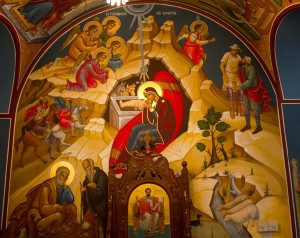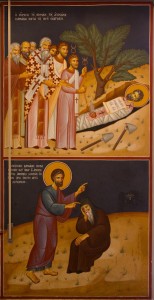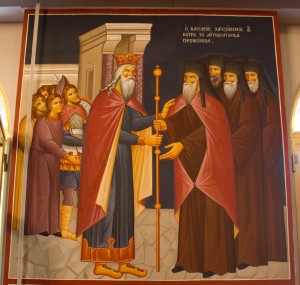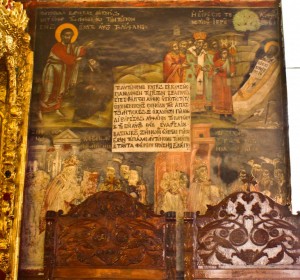Barnabas at the Archbishopric
October 27th, 2011

Note the chair in front of this Nativity painting on a chapel wall. On the back of the chair is a painting of Barnabas.
I had an appointment this morning with a man at the Archbishopric to take photos of artwork depicting Barnabas. Although there often is a dearth of icons of Barnabas in churches around the island, he is everywhere in the Archbishopric.
Just inside the main door is a recent mosaic of Barnabas. In the archbishop’s office is a large painting of Barnabas on one of the walls (I did not yet get a photo of that one). In a chapel on the second floor, there are brand new paintings on the walls and ceiling. I noticed that the back of the chair in front of the painting depicting Jesus’ birth has an icon-like painting of Barnabas.

The bottom panel of this painting depicts Barnabas appearing to Anthemius in the late fifth century. The top panel depicts Anthemius finding Barnabas's body.
In the main assembly room where the archbishop meets with people for business, a major part of one wall is devoted to depicting the late fifth-century events where, according to tradition, Barnabas appeared in a vision to Anthemius, Bishop of Constantia—showing his burial site. These paintings have for centuries been presented using four panels. The first is the vision. The second is Anthemius finding the body of Barnabas with a copy of the Gospel of Matthew on the apostle’s chest. The third is Anthemius presenting the Gospel of Matthew to the emperor Zeno. The fourth is the emperor Zeno giving a scepter to Anthemius, indicating the special, royal privileges given to the archbishop of Cyprus.
These four panels tell visually the story of how Cyprus maintained its ecclesiastical independence. Barnabas is the saint who helped to establish Cypriot autonomy—an important religious and political symbol for the Archbishopric in Nicosia.
The man who opened the doors for me and waited while I took the photos also walked with me out through the guard’s gate to the nearby Cathedral of St. John—an older structure covered inside with frescos. Of course, one of the frescos is a four-panel depiction of Anthemius finding the body of Barnabas, etcetera.
The fresco is weathered and faded. The church is very dim inside. And the fresco is right beside a window. Talk about a challenging set of conditions for taking photographs (without a flash, of course). So I used the HDR technique to produce an image that is semi-visible. I wish that I could have moved the chairs that block the view of the bottom two panels of the fresco. But I did not want to press my luck.
I smile sometimes when I think of how many of the significant Cypriot religious leaders I have met. Having a Fulbright and conducting research on Barnabas have opened lots of doors for me. Tonight, however, all these enriching experiences pale because of one irritating situation. For the first time since coming to Cyprus, I am sick. Miserable. I hope that it is a short-term illness and does not drag out for a week. Lynne’s mother and two sisters are flying to Cyprus on Friday, and I want to be in good shape for the visit.
Posted in Uncategorized | Comments Off on Barnabas at the Archbishopric



